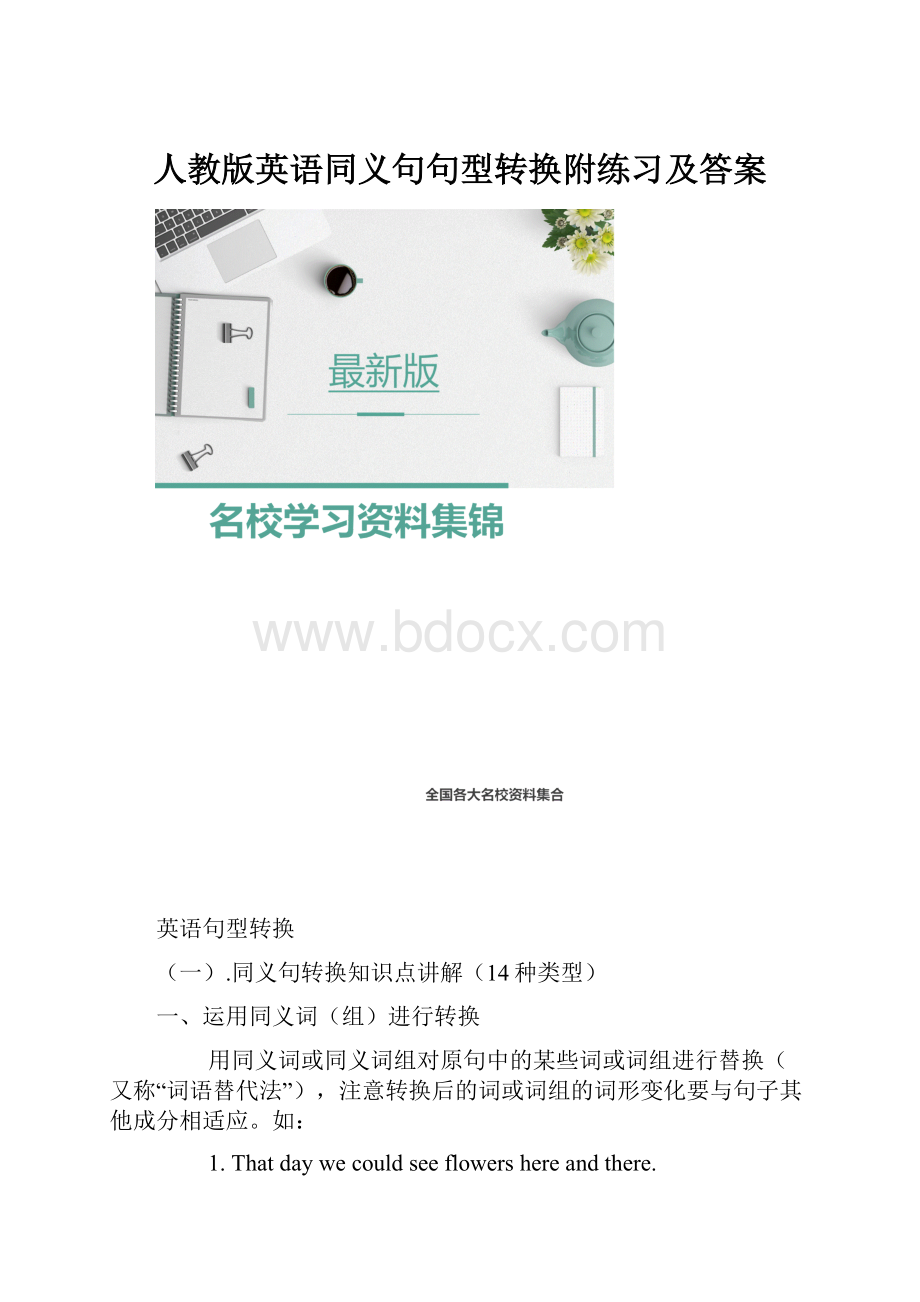人教版英语同义句句型转换附练习及答案.docx
《人教版英语同义句句型转换附练习及答案.docx》由会员分享,可在线阅读,更多相关《人教版英语同义句句型转换附练习及答案.docx(19页珍藏版)》请在冰豆网上搜索。

人教版英语同义句句型转换附练习及答案
英语句型转换
(一).同义句转换知识点讲解(14种类型)
一、运用同义词(组)进行转换
用同义词或同义词组对原句中的某些词或词组进行替换(又称“词语替代法”),注意转换后的词或词组的词形变化要与句子其他成分相适应。
如:
1.Thatdaywecouldseeflowershereandthere.
Thatdaywecouldseeflowers__________.
分析:
答案为everywhere。
everywhere与hereandthere都表示“到处”。
2.Theteacheralwaystakesgoodcareofthechildrenintheschool.
Theteacheralways_____________thechildrenwellintheschool.
分析:
答案为looksafter。
takegoodcareof与lookafter…well都表示“好好照顾”。
3.Thechildrenarewearingbeautifulclothes.
Thechildrenare_________beautifulclothes.
4.Everyday,YaoMingreceivesE-mailsfromthousandsofbasketballfans.
Everyday,YaoMing_________thousandsofbasketballfans.
5.Mr.Smithisworking.
Mr.Smithis____________________.
答案:
1.in2.hearsfrom3.atwork
二、运用反义词(组)的否定式进行转换
即用反义词或词组的否定式表达与原句相同的意思,主要考查学生对反义词(词组)的积累和换位思维的能力。
如:
1.It’sclearthatthisvisitisdifferentfromlasttime.
It’sclearthatthisvisitisnotthe______lasttime.
分析:
答案为sameas。
bedifferentfrom意为“与……不同”;thesameas意为“与……相同”,其否定式与bedifferentfrom同义。
2.Ithinkwealthislessimportantthanhealth.
I___thinkwealthis___importantthanhealth.
分析:
答案为don’t,more。
lessimportant的意思是“没有(不及)……重要”;moreimportant的意思是“(比)……更重要”,该结构与not连用,则表示“不比……更重要”。
3.ChineseismorepopularthanJapanese.
Japaneseis__________popular__________Chinese.
4.Therunnercouldn'tcatchupwiththeothersintherace.
Therunner___________________theothersintherace.
5.AcomputerismoreusefulthanaVCD.
AVCDisnot_________useful_________acomputer.
答案:
4.less,than5.fellbehind6.as,as
另外,有的反义词即使不与否定词连用,而只需改变句子结构也可构成同义句。
如:
Helentsomemoneytohisfriend.
Hefriend___somemoney___him.
分析:
答案为borrowed,from。
borrow…from意为“向……借……”;lend…to意为“把……借给……”。
两个结构意思相反,但若变换“借出者”与“借入者”的位置,则可转换为同义句。
三、运用不同语态进行转换
即运用主动语态与被动语态的变化来转换同义词,但此时要特别注意时态、动词一致性。
如:
1.Everyoneshouldgivebackhislibrarybooksontime.
Librarybooksshould____________ontime.
分析:
答案为begivenback。
被动句中含有情态动词should,因此助动词用be。
2.Itiswidelyacceptedthatmorepeopleusecomputersintheworldtoday.
Computers____widely___intheworldtoday.
分析:
答案为are,used。
computers是复数名词,助动词用are。
3.Youmusttidyyourbedroomeveryday.
→Yourbedroommustbetidiedeveryday.
4.Thefarmgrowscotton.
→Cottonisgrownonthefarm.
四、非延续性动词与延续性动词的相互转换
即非延续性动词与延续性动词进行转换,此时往往会涉及时态的变化。
如:
1.Themanagerlefttwohoursago.
Themanager_____________fortwohours.
分析:
答案为hasbeenaway。
leave为非延续性动词,不能与fortwohours这样的一段时间连用,而改成beaway这样的延续性动词后,则可连用一段时间。
2.Thefilmbeganfiveminutesago.
Thefilmhasbeen__________fiveminutes.
分析:
答案为onfor。
hasbeen提示时态是现在完成时态,“for+时间段”表示“持续(一段时间)”,常用在含有现在完成时态的句子里。
3.MrLijoinedthePartytwentyyearsago.
MrLi_______________thePartyfortwentyyears.
答案:
hasbeenin。
短暂动词join,意为“参加、加入(组织,政党)”,不能与延续时间状语连用,与延续性时间状语连用时,将join改成bein或beamemberin…。
五、运用不同引语进行转换
即将直接引语变为间接引语或将间接引语转换成直接引语。
此时还要注意相关时态、人称、动词、状语等相应的变化。
如:
1.“I’vefoundmywallet,”hesaidtome.
He_________methathe__________________hiswallet.
分析:
答案为told,hadfound。
此题是将直接引语转换成间接引语。
2.“Didyouseeherlastweek?
”hesaid.
He______________Ihadseenhertheweek_______.
分析:
答案为askedif/whether,before。
此题是将疑问句的直接引语转换成间接引语。
六、运用简单句与复合句之间的转换
即将简单句变成同义的复合句或将复合句变成同义的简单句。
(1).复合句化为简单句一般侧重于将从句变化为短语或词组,使句意简单明了。
①用不定式、介词短语、名词短语、分词性短语等替换复合句中的句子;
②将宾语从句简化为“疑问词+不定式”;
③将so...that...,或such...that...引导的状语从句简化为含有too...to...,enough...to...简单句;④将if引导的状语从句简化为“祈使句,and(or)+一般将来时”的句子.
(2).必须注意的是,简单句变为复合句时,很多情况下是把宾语扩大为宾语从句,从句中使用一般将来时或“情态动词+动词原形”。
如:
1.Wedidn’tgooutforawalkbecauseitwasraining.
Wedidn’tgooutforawalk______________therain.
分析:
答案为becauseof。
将原因状语从句becauseitwasraining改为表示原因的介词短语becauseoftherain。
2.Hewassoexcitedthathecouldn’tgotosleep.
Hewas_________________gotosleep.
分析:
答案为tooexcitedto。
将so…that…换成too…to…结构,原句的that从句为结果状语从句,改写句中的不定式仍表结果。
3.NowIwillshowyouhowtodothework.
NowIwillshowyou__________________dothework.
分析:
答案为howyoucan。
即将原句中的“疑问词+不定式”结构转换成宾语从句。
4.Youshouldputthembackafteryouusethem.
Youshouldputthemback__________them.
分析:
答案为afterusing。
即将after引导的状语从句改写为after引导的介词短语。
5.IhopethatIcanseeyouagain.
→Ihopetoseeyouagain.
6.Pleasetellmewhereweshowourtickets.
→Pleasetellmewheretoshowourtickets.
7.Ifyoudon'thurryup,you'llmisstheearlybus.
→Hurryup,oryouwon'tcatchtheearlybus.
七、运用并列句与复合句之间的转换
即将并列句变成同义的复合句或将复合句变成同义的并列句。
如:
1.Comeon,orwe’llmisstheearlybus.
____we____hurry,we’llmisstheearlybus.
分析:
答案为If,don’t。
if引导条件状语从句。
2.Themangaveusatalklastweek.Nowhewillgiveusanothertalkthisweek.
Theman_____gaveusatalklastweek__________usanothertalkthisweek.
分析:
答案为who/that,willgive。
who/thatgaveusatalklastweek为定语从句,修饰先行词theman。
八、运用关联连词连接或合并句子
即运用关联连词both…and…,neither…nor…,either…or…,notonly…butalso…等将两个简单句合并为一个简单句。
此时要注意的是,both…and…连接两个主语时,谓语总是用复数,而neither…nor…,either…or…,notonly…butalso…连接两个主语时,谓语动词通常应与靠近的主语保持一致。
如:
1.Tomcan’tspeakJapanesewellandJimcan’t,either.
______Tom______JimcanspeakJapanesewell.
分析:
答案填Neither,nor。
neither…nor…表示“……和……(两者)都不”,刚好与原句的两个否定结构的意思相吻合。
2.AlicehasreadthebookandPeterhasreadit,too.
______Alice______Peterhavereadthebook.
分析:
答案为Both,and。
both…and…的意思是“……和……(两者)都”。
3.Thisstoresellsmen’sshoes,anditalsosellsmen’sclothes.
Thisstoresells____________men’sshoes____________men’sclothes.
分析:
答案为notonly,butalso。
表示“不仅……而且……”之意。
4.Hehasn'tbeentoFrance.Shehasn'tbeentoFrance,either.
→NeitherhenorshehasbeentoFrance.
5.Theroonisn'tverybig.Itcan'tholdalotofpeople.
→Thisroomisn'tbigenoughtoholdalotofpeople.
6.MrsSmithismyteacher.Sheisalsomygoodfriend.
→MrsSmithisnotonlymyteacherbutalsomygoodfriend.
九、变成含有宾语从句的复合句
首先要判断所给句子是哪一类型(陈述句、特殊疑问句还是一般疑问句),然后确定所需要的连词,同时必须注意时态的对应和陈述句语序。
1.Shemissedusverymuch.Shetoldus.
→Shetoldusthatshemissedverymuch.
2.IsMrNobelateacher?
Couldyoutellme?
→CouldyoutellmeifMrNobelisateacher?
3.Where'stheforeignerfrom?
Heasked.
→Heaskedwheretheforeignerisfrom.
十、用以it作形式主语的句型进行转换
不定式所表示的动作发出者一般是句子的主语,但有时却不是,这时不定式常会带上自己的逻辑主语,这一主语通常由介词for引出。
1.Hecanfinishtheworkeasily.
→Itiseasyforhimtofinishthework.
2.Hefoundtosleepwasverydifficult.
→Hefounditwasverydifficultforhimtosleep.
3.TolearnEnglishwellisnoteasy.
→ItisnoteasytolearnEnglishwell.
十一、利用某些典型句式或结构进行转换
这类典型结构如so…that…,too…to…,enoughto,not…until…,sodoI等。
要在把握句意的基础上对原句进行概括表达,遇到困难要多换个角度去思考,需要反复推敲才行。
如:
1.Jimwantstogoboatingandhisparentswanttogoboating,too.
Jimwantstogoboating,and____________hisparents.
分析:
答案为sodo。
句意为“……他的父母也一样(一样想去)”。
2.Johnwenttobedafterhefinishedhishomework.
John______gotobed______hefinishedhishomework.
分析:
答案为didn’t,until。
not…until意为“直到……才”。
特别提示:
so...that...,too...to...,enough...to...是初中英语教材中三个重要的句型结构,在一定条件下它们可以互相转换。
①so...that...与enough...to...的转换
当that引导的从句是肯定的,从句主语与主句主语相同时,so...that...可转化为enough...to...结构;若从句主语与主句主语不相同时,so...that...可转化为enoughforsb.to...结构.
Tomissooldthathecangotoschool.
→Tomisoldenoughtogotoschool.
Theboxissolightthatthechildcanliftit.
→Theboxislightenoughforthechildtolift.
当that引导的从句是否定的,从句主语与主句主语相同时,so...that...可转化为enough...to...否定结构;若从句主语与主句主语不相同时,so...that...可转化为enoughforsb.to...否定结构,但须注意的是,转换后的形容词(副词)要用其相应的反义词。
Themanissooldthathecan'tgotowork.
→Themanisn'tyounyenoughtogotowork.
ThedeskissoheavythatIcan'tmoveit.
→Thedeskisn'tlightenoughformetomove.
②so...that...与too...to...转换
当that引导的从句是否定的,从句主语与主句主语相同时,so...that...可转化为too...to...结构;若从句主语与主句主语不相同时,so...that...可转化为too...forsb.to...结构。
Heissoyoungthathecan'tgotoschool.
→Heistooyoungtogotoschool.
TheboxissoheavythatIcan'tmoveit.
→Theboxistooheavyformetomove.
③enough...to...与too...to...转换
enough...to...句式为否定式时,可以转换为too...to...结构,但转换后的结构中too...to...的形容词(副词)要用其相应的反义词。
Heisnotoldenoughtodothejob.
→Heistooyoungtodothejob.
Tomdidn'twalkslowlyenoughforustokeepupwithhim.
→Tomwalkedtoofastforustokeepupwithhim.
十二、用同义句改写
英语中有很多意义相同(相近)但结构不同的句型、句式,这些句型大多是学习的重点常见的有:
①notas...as...与比较级的转换;②thananyother与最高级的转换;③when(after,before)引导的从句与not...until的转换;④瞬间动词(come,go,leave,buy,die,begin,borrow...)的过去时与含有一段时间状语的完成时的转换;⑤take,cost,spend,payfor的转换;⑥询问价格的几个句型的互相转换;⑦what引起的感叹句与how引起的感叹句的转换等。
Shespent30dollarsontheEnglish-Chinesedictionary.
→TheEnglish-Chinesedictionarycosther30dollars.
→Shepaid30dollarsfortheEnglish-Chinesedictionary.
→Shespent30dollarsbuyingtheEnglish-Chinesedictionary.
Howcleverthemanis!
→Whataclevermanheis!
Howoldareyou?
→What'syourage?
Wecamehomewhenitwassixo'clock.
→Wedidn'tcomehomeuntil/beforeitwassixo'clock.
十三、用派生词或一词多义改写
此类题型可采用“词类转化法”,利用某些派生词或词性相异的词组来代替原句中的某些成分,此时句子结构一般会随之发生一些变化。
例如:
Thesnowwasheavylastnight.
→Itsnowedheavilylastnight.
TheforeignershavevisitedtheGreatWall.
→TheforeignershavebeenonavisittotheGreatWall.
十四、用介词短语改写
Mybrotherwenttocollegewhenhewasseventeen.
→Mybrotherwenttocollegeattheageofseventeen.
Tommydidn'thavebreakfastandwenttoschool.
→Tommywenttoschoolwithouthavingbreakfast.
Iusuallywalktoschool.
→Iusuallygotoschoolonfoot.